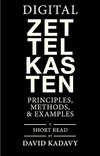
Digital Zettelkasten: Principles, Methods, & Examples

Some people have a whole list of metadata points they capture for every single note. They use text-expanding software that allows them to – by typing just a couple characters – generate this entire list. Like so: Title: Author: Web: Date Created: Date Edited: Tags:
David Kadavy • Digital Zettelkasten: Principles, Methods, & Examples
Here’s a table describing which activities I do in which contexts:
David Kadavy • Digital Zettelkasten: Principles, Methods, & Examples
Choosing the right keywords or tags for your Zettelkasten allows it to work as a non-hierarchical database of your knowledge and ideas. As you collect notes related to a given topic, you start building the raw materials for a finished piece. But your first instincts for how to choose keywords for a note may hurt more than they help. This quote from
... See moreDavid Kadavy • Digital Zettelkasten: Principles, Methods, & Examples
Choosing keywords/tags
David Kadavy • Digital Zettelkasten: Principles, Methods, & Examples
Experienced academic readers usually read a text with questions in mind and try to relate it to other possible approaches, while inexperienced readers tend to adopt the question of a text and the frames of the argument and take it as a given. What good readers can do is spot the limitations of a particular approach and see what is not mentioned in
... See moreDavid Kadavy • Digital Zettelkasten: Principles, Methods, & Examples
Look at the highlights of your highlights and re-write the interesting ones in your own words. You're now turning your fleeting notes into a literature note. It's okay not to summarize every highlight. Only worry about the information you most want to learn or that you can foresee wanting to use in the future.
David Kadavy • Digital Zettelkasten: Principles, Methods, & Examples
(Tiago Forte calls the highlighting of highlights "progressive summarization.")
David Kadavy • Digital Zettelkasten: Principles, Methods, & Examples
The educational psychologist Kirsti Lonka compared the reading approach of unusually successful doctoral candidates and students with those who were much less successful. One difference stood out as critical: The ability to think beyond the given frames of a text (Lonka 2003, 155f). Experienced academic readers usually read a text with questions in
... See moreDavid Kadavy • Digital Zettelkasten: Principles, Methods, & Examples
Search engines and the internet are not a substitute for your notes. Your notes contain more than just simple facts, managing your notes builds your memory, and your notes help you store and develop ideas in-progress.